Italian Seafood Linguine
Seafood linguine is a classic Italian pasta dish known for its delicious combination of fresh seafood and linguine noodles. The dish typically consists of linguine noodles tossed with an assortment of seafood such as shrimp, scallops, clams, and mussels, olive oil and fresh parsley. The perfect dish with friends or family.
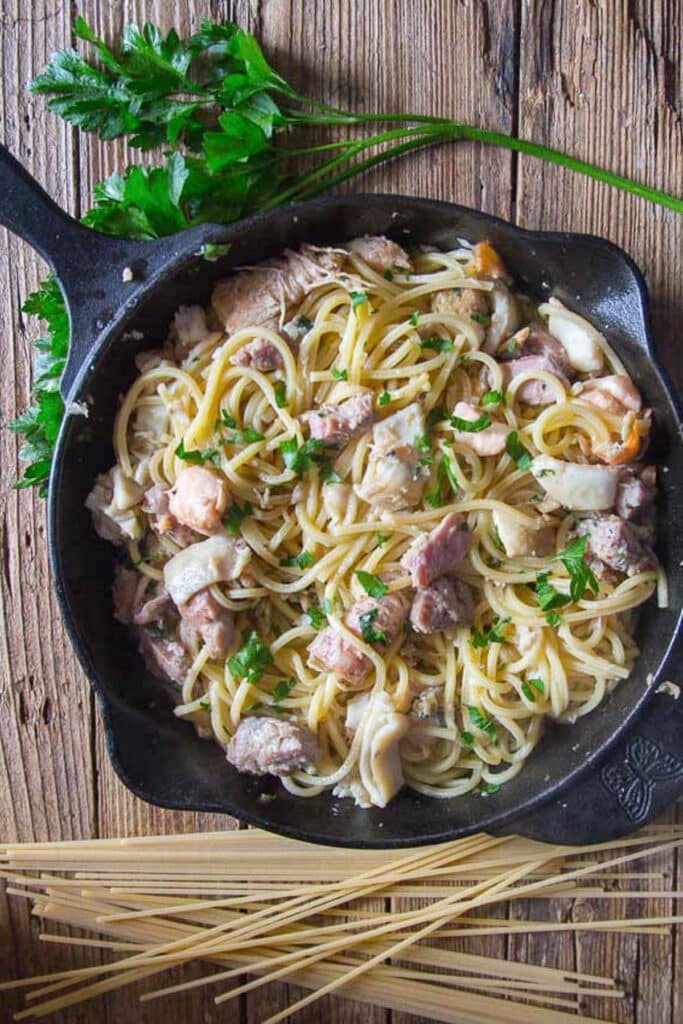
I was never a big lover of fish or seafood, that is until I moved to Italy. I love how Italians made and served it especially when it came to pasta such as Tuna and Olive pasta or Italian Buccala pasta or this must try Smoked Salmon Cream Sauce or even main dishes such as Grilled Salmon, Sautéed Shrimp or Baked fish.
Ingredients for Seafood Linguine
- Seafood – seafood mixture shrimp, crab, prawns, clams, mussels, calamari rings, cod, haddock, calamari rings and haddock cut in small pieces
- Parsley – Italian parsley also known as flat leaf parsley
- Olive oil – extra virgin olive oil
- Hot red-pepper flakes – optional
- Salt
- White wine – optional
- Pasta – linguine or spaghetti
What is the best pasta to use
Traditionally Italians will make this recipe with either spaghetti or linguine, just make sure you use a good quality pasta and always check the package directions before making, some need longer cooking time than others.
What wine is good for cooking with?
A dry white wine is usually best for cooking. Pinot Grigio, Sauvignon Blanc, and Chardonnay would make nice choices. If you don’t like to drink it then don’t use it for cooking.
How to make Seafood Linguine recipe
In a large pot of boiling salted water add the linguine and cook very al dent.
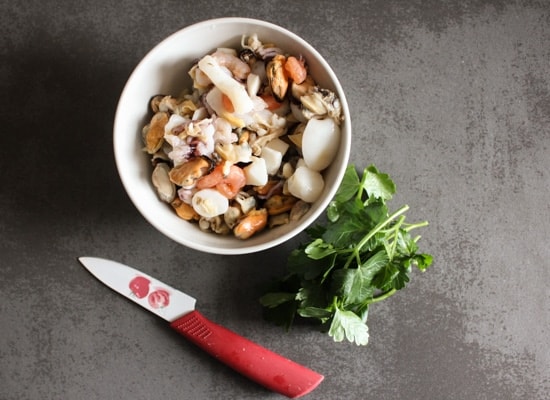
While pasta is cooking, in a large skillet or frying pan add the olive oil, seafood, chopped parsley, hot pepper flakes and salt to taste. Cook on medium heat until fish is cooked. If you wish to add wine add it with the seafood and cook on high for 30-60 seconds until evaporated then continue with the cooking.

Add the pasta and some pasta water to the frying pan, gently toss and cook for another minute or two. Serve immediately, sprinkled with some chopped parsley.
In the early days of my arrival in Italy I learned and tasted so many different pasta dishes my taste buds were jumping for joy every time they saw my mother-in-law put the big pot of water on to boil.
She made pasta with ingredients I would never even think to make. Spaghetti and Broccoletti (broccoli Rabe), Spaghetti e Alici (anchovies) to name but a couple and everything mouth-watering.
Can you use frozen seafood?
You can even use frozen fish, just make sure there is nothing added, no sauce or spices. Let it thaw then drain to remove excess moisture.
How to cook pasta
Always cook the pasta in enough water, you will need 4 cups (1 litre) for 3 1/2 ounces (100 grams) of pasta. Be sure to choose the correct size pot, you don’t want the water to reach the rim and overflow, because pasta, when cooked, can increase in volume up to three times. Always cover the pot when boiling the water, but remove it once the pasta has been added.
Calculate about 7 g of salt for every litre of water. Add the salt only when the water has reached a boil and never before.
After adding the pasta to the pot, bring it back to a boil and keep it at a boil while the pasta is cooking. This allows the pasta to achieve an even cooking, be sure to stir frequently while it is cooking.
Never pass the freshly drained pasta under running tap water. You should never stop the cooking, even when you are making a cold pasta salad, let it cool by adding a drizzle of olive oil to prevent it from sticking.
Drain the pasta al dente, this is done by tasting, if it has a bite to it it’s ready, nothing worse than mushy pasta. If you have to toss the pasta in a pan with sauce (like this recipe) then cook it at least one minute less (pasta very al dente).
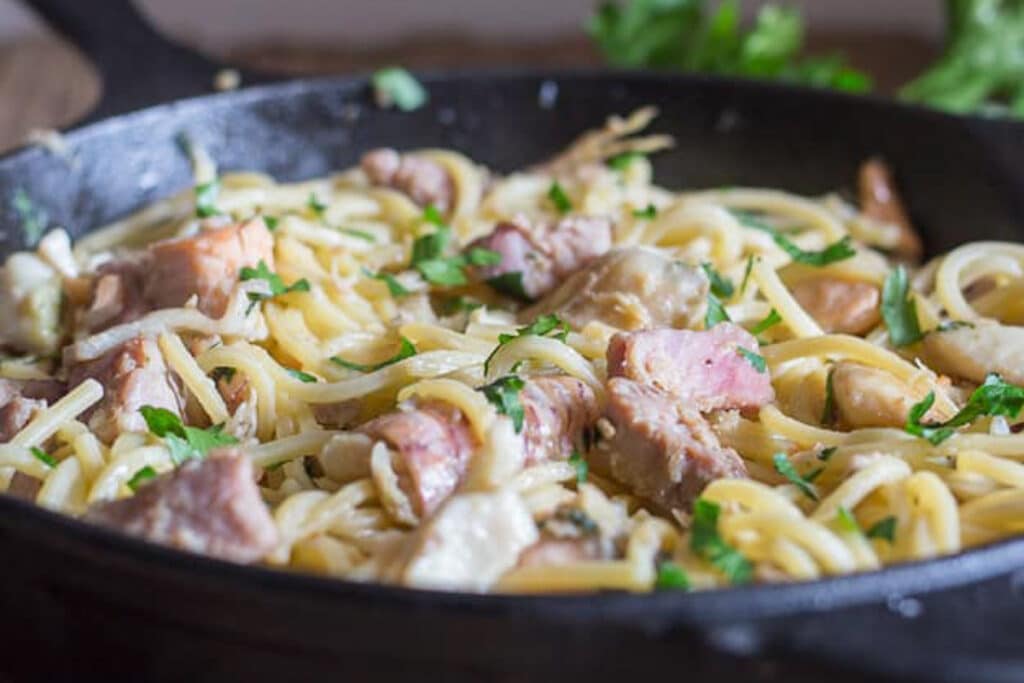
Why don’t Italians add cheese to fish dishes?
Italy changed radically after the Second World War, and people became very protective of local traditions. Which brought regional flavors back to the Italian cuisine. One reason could have been why fish and cheese do not get along would be for geographical reasons.
Fish was mostly eaten in coastal areas, while cheese was produced inland, another could be that the delicate flavor of fish and the strong and overpowering one of the cheese do not mix.
Although Ken Albala, a food historian suggests instead that in the theories of Hippocrates and Galen, reference was made to the chemical transformation of fish once in contact with cheese, a contamination that would have damaged the whole digestion.
They were continued to be kept separate even in the Middle Ages and the Renaissance, up to modern Italian cookbooks. It is a nonacceptance that was strengthened in the twentieth century, and it still remains a cornerstone of Mediterranean cuisine in Italy.
How to store it
This is one type of pasta dish that is best consumed at the time it is made. If you do have leftovers, then store in an airtight container and refrigerate for up to 1 day, re-heat on the stove, add a little water (pasta water if available) and heat through.
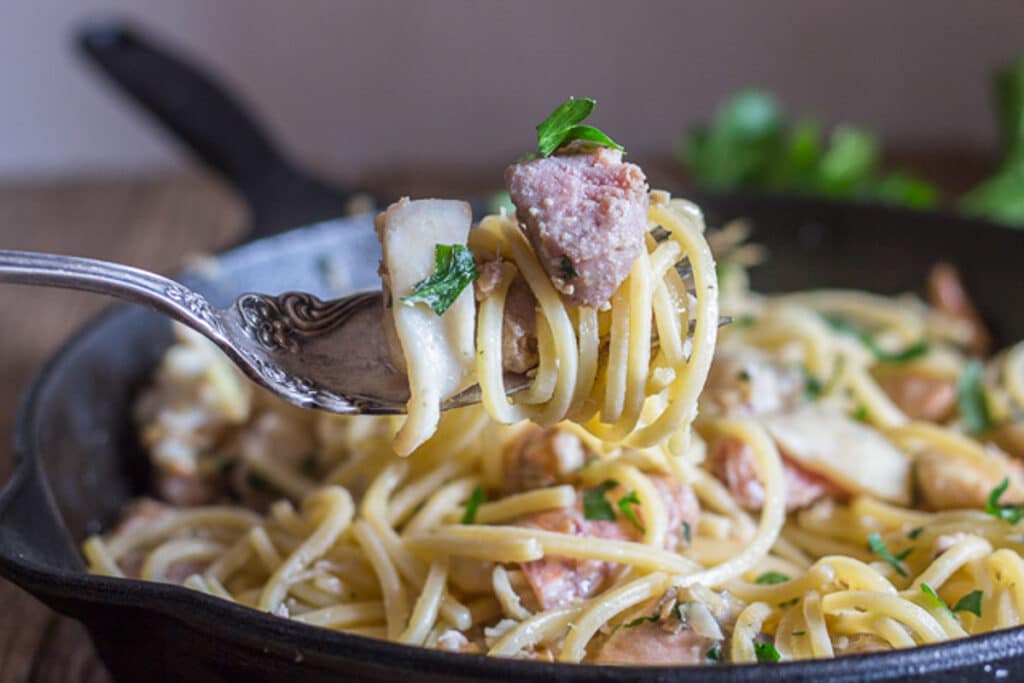
With its rich flavors and easy preparation, I hope Italian Seafood Linguine becomes a favorite in your home as it is in ours. Buon Appetito!
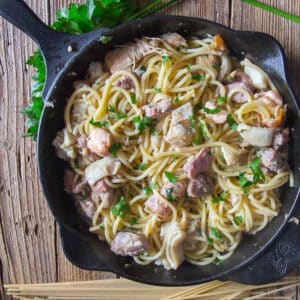
Italian Seafood Linguine
Ingredients
- 2 cups mixed seafood (shrimp, clams, mussels, calamari rings, cod, haddock) calamari rings and haddock cut in small pieces)
- ¼ cup chopped fresh parsley
- ¼ cup olive oil
- 1-3 dashes hot pepper flakes
- 1-2 pinches salt to taste
- ¼ cup white wine (good quality) optional
- 3 cups cooked linguine or spaghetti
Instructions
- In a large pot of boiling salted water add linguine and cook very al dent.
- While pasta is cooking, in a large skillet or frying pan add the olive oil, seafood, chopped parsley, hot pepper flakes and salt to taste. Cook on medium heat until fish is cooked. If you wish to add wine add it with the seafood and cook on high for 30-60 seconds until evaporated then continue with the cooking.
- Drain pasta (keeping 1/2 ladle of pasta water), add pasta to frying pan with pasta water, gently toss and cook for another 30-60 seconds, while tossing occasionally. Serve immediately, sprinkled with some chopped parsley. Enjoy!
- Add the pasta and ¼ cup pasta water to the frying pan, gently toss and cook for another minute or two. Serve immediately, sprinkled with some freashly chopped parsley. enjoy!
Notes
Nutrition
Republished from January 13, 2016.
Oh wow, this is right up my street!
We are very lucky here and we get amazing seafood, cannot wait to add this to our dinner rotation!
Hi Claire, hope you enjoy it, let me know.
one of my favorite things xo
Hi Katherine, I totally agree.
Those photos are gorgeous! I will have to make this parents the next time they come for dinner. They would LOVE it!
Hi Jessica, thanks hope they enjoy it. Have a great weekend.
This looks amazing! I’m a big fan of seafood myself, but I can see how someone who isn’t might still be tempted by the seafood pasta yumminess!
Thanks Rachel, yes it is pretty yummy! 🙂
I bet this is amazing – I don’t cook a lot of fish, either, probably because I grew up smack-dab in the middle of the US where good fresh fish just wasn’t available. Might be time to add some dishes to my lists — starting with this one! 🙂
Thanks April, I know what you mean, living here, there is fish everywhere. Have a great weekend.
Looks yummy. The more fish in a dish the better. I’m going to try your mother’s salmon spread. I can never get enough of salmon. Thanks for the recipe.
Hi Ann, glad you like it, let me know about the dip, it is a big hit here.